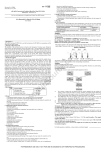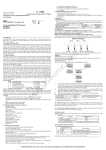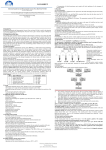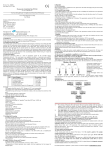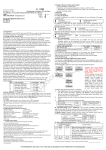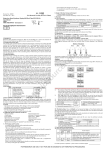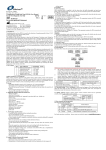Download Real Time RT-PCR Kit
Transcript
• Wear separate coats and gloves in each area. • Do not pipette by mouth. Do not eat, drink, smoke in laboratory. • Avoid aerosols 8. Sample Collection, Storage and transport • Collected samples in sterile tubes; • Specimens can be extracted immediately or frozen at -20°C to -80°C. • Transportation of clinical specimens must comply with local regulations for the transport of etiologic agents 9. Procedure 9.1 RNA-Extraction RNA extraction kits are available from various manufacturers. You may use your own extraction systems or the commercial kit based on the yield. For the RNA extraction, please comply with the manufacturer’s instructions. The recommended extraction kit is as follows:: Nucleic Acid Isolation Kit Cat. Number Manufacturer RNA Isolation Kit ME-0010/ME-0012 ZJ Biotech QIAamp Viral RNA Mini extraction Kit (50) 52904 QIAGEN 9.2 Positive Control Attention: It is necessary to dilute the positive control supplied in the kit to 107 copies/ml by 10 times with molecular grade water before detection, and close the tube immediately then vortex for 10 seconds. 9.3 Quantitation The kit can be used for quantitative or qualitative real-time RT-PCR. For performance of quantitative real-time PCR, Standard dilutions must prepare first as follows. Molecular Grade Water is used for dilution. Dilution is not needed for performance of qualitative real-time PCR. Revision No.: ZJ0006 Issue Date: Jul 1st, 2015 Leukemia BCR-ABL Fusion Gene (μ-BCR) Real Time RT-PCR Kit MBS598269 - Instrument I, II For Use with LightCycler 1.0/LightCycler2.0Real Time PCR Systems (For Research Use Only In USA & China) User Manual 7 om ce .c To generate a standard curve on the real-time system, all four dilution standards should be used and defined as standard with specification of the corresponding concentrations. Attention: A. Mix thoroughly before next transfer. B. The positive control contains high concentration of the target DNA. Therefore, be careful during the dilution in order to avoid contamination. 9.4 RT-PCR Protocol The Master Mix volume for each reaction should be pipetted as follows: M yB io So ur 1. Intended Use Leukemia BCR-ABL Fusion Gene(μ-BCR) real time RT-PCR Kit is used for the detection of micro(μ) BCR-ABL gene variants (e19a2) in leukocyte by using real time PCR systems. 2. Principle of Real-Time PCR The principle of the real-time detection is based on the fluorogenic 5’nuclease assay. During the PCR reaction, the DNA polymerase cleaves the probe at the 5’ end and separates the reporter dye from the quencher dye only when the probe hybridizes to the target DNA. This cleavage results in the fluorescent signal generated by the cleaved reporter dye, which is monitored real-time by the PCR detection system. The PCR cycle at which an increase in the fluorescence signal is detected initially (Ct) is proportional to the amount of the specific PCR product. Monitoring the fluorescence intensities during Real Time allows the detection of the accumulating product without having to re-open the reaction tube after the amplification. 3. Product Description The BCR-ABL fusion gene is associated with formation of the Philadelphia chromosome (Ph) and is one of the most common genetic abnormalities detected in leukaemia’s. In the vast majority of patients, the breakpoints in the BCR gene are clustered within three well defined regions. One fusion gene called μ-bcr ,it is ver rare. The breakpoint located in the bcr region, resulting in an e19a2 fusion transcript, which encodes for a longer 230 kDa BCR-ABL protein. e19a2 CML has been associated with chronic neutrophilic leukaemia (CNL).Leukemia BCR-ABL Fusion Gene(μ-BCR) real time RT-PCR kit contains a specific ready-to-use system for the detection of the Leukemia BCR-ABL Fusion Gene(μ-BCR) using RT-PCR (Reverse Transcription Polymerase Chain Reaction) in the real-time PCR system. The master contains Super Mix for the specific amplification of -BCR. The reaction is done in one step real time RT-PCR. The first step is a reverse transcription (RT), during which the Leukemia BCR-ABL Fusion Gene(μ-BCR) is transcribed into cDNA. Afterwards, a thermostable DNA polymerase is used to amplify the specific gene fragments by means of PCR (polymerase chain reaction). Fluorescence is emitted and measured by the real time systems optical unit during the PCR. The detection of amplified BCR-ABL fragment is performed in fluorimeter channel FAM. An external positive control (1×108copies/ml) supplied, allows the determination of the gene load. For further information, please refer to section 9.3 Quantitation. 4. Kit Contents Ref. Type of reagent Presentation 25rxns 1 μ-BCR Super Mix 1 vial, 380l 2 RT-PCR Enzyme Mix 1 vial, 28l 3 Molecular Grade Water 1 vial, 400μl 4 μ-BCR Positive Control (1×108copies/ml) 1 vial, 30μl 5. Storage • All reagents should be stored at -20°C. Storage at +4°C is not recommended. • All reagents can be used until the expiration date indicated on the kit label. • Repeated thawing and freezing (> 3x) should be avoided, as this may reduce the sensitivity of the assay. • Cool all reagents during the working steps. • Super Mix should be stored in the dark. 6. Additionally Required Materials and Devices • Biological cabinet • Real time PCR system • Desktop microcentrifuge for “eppendorf” type tubes (RCF max. 16,000 x g) • Vortex mixer • RNA extraction kit • Real time PCR reaction tubes/plates • Cryo-container • Pipets (0.5 μl – 1000 μl) • Sterile filter tips for micro pipets • Sterile microtubes • Disposable gloves, powderless • Biohazard waste container • Refrigerator and freezer • Tube racks 7. Warnings and Precaution Carefully read this instruction before starting the procedure. • For in vitro diagnostic use only. • This assay needs to be carried out by skilled personnel. • Clinical samples should be regarded as potentially infectious materials and should be prepared in a laminar flow hood. • This assay needs to be run according to Good Laboratory Practice. • Do not use the kit after its expiration date. • Avoid repeated thawing and freezing of the reagents, this may reduce the sensitivity of the test. • Once the reagents have been thawed, vortex and centrifuge briefly the tubes before use. • Prepare quickly the Reaction mix on ice or in the cooling block. • Set up two separate working areas: 1) Isolation of the RNA/ DNA and 2) Amplification/ detection of amplification products. • Pipets, vials and other working materials should not circulate among working units. • Use always sterile pipette tips with filters. Take positive control (1×10 copies/ml) as the starting high standard in the first tube. Respectively pipette 36ul of Molecular Grade Water into next three tubes. Do three dilutions as the following figures: 1) The volumes of Super Mix and Enzyme Mix per reaction multiply with the number of samples, which includes the number of controls, standards, and sample prepared. Molecular Grade Water is used as the negative control. For reasons of unprecise pipetting, always add an extra virtual sample. Mix completely then spin down briefly in a centrifuge. 2) Pipet 15μl Master Mix with micropipets of sterile filter tips to each of the Real time PCR reaction plate/tubes. Separately add 5μl RNA sample, positive and negative controls to different plate/tubes. Immediately close the plate/tubes to avoid contamination. 3) Spin down briefly in order to collect the Master Mix in the bottom of the reaction tubes. 4) Perform the following protocol in the instrument: 45°C for 10 min, 1 cycle; 95°C for 15 min, 1 cycle; 95°C for 5 sec, 60°C for 30sec, 40 cycles. Fluorescence is measured at 60°C;channel FAM should be chosen. 10. Baseline setting: just above the maximum level of molecular grade water. 11.Calabration for quantitative detection: Input each concentration of standard controls at the end of run, and a standard curve will be automatically formed. 12.Quality control: The crossing point value of molecular grade water and positive control in FAM channel shows blank and ≤35 respectively; Correlation coefficient of standard curve should be ≤-0.98, otherwise the result is invalid. 13. Data Analysis and Interpretation The following results are possible: 1) The crossing point value in channel FAM of μ-BCR Super Mix shows ≤38. The sample contains micro(μ) BCR-ABL gene variants (e19a2). 2) The crossing point value in channel FAM shows 38~40, please repeat again. If the result still shows 38~40,it can be considered negative. 3) In channel FAM no signal is detected. The sample does not contain any micro(μ) BCR-ABL gene variants (e19a2). It can be considered negative. For further questions or problems,please contact our technical support FOR RESEARCH USE ONLY. NOT FOR USE IN DIAGNOSTIC OR THERAPEUTIC PROCEDURES. • Avoid repeated thawing and freezing of the reagents, this may reduce the sensitivity of the test. • Once the reagents have been thawed, vortex and centrifuge briefly the tubes before use. • Prepare quickly the Reaction mix on ice or in the cooling block. • Set up two separate working areas: 1) Isolation of the RNA/ DNA and 2) Amplification/ detection of amplification products. • Pipets, vials and other working materials should not circulate among working units. • Use always sterile pipette tips with filters. • Wear separate coats and gloves in each area. • Do not pipette by mouth. Do not eat, drink, smoke in laboratory. • Avoid aerosols. Revision No.: ZJ0008 Issue Date: Jul 1st, 2015 (For Research Use Only In USA & China) Leukemia BCR-ABL Fusion Gene (μ-BCR) Real Time RT-PCR Kit User Manual MBS598269 - Instrument III, IV For use with ABI Prism®7000/7300/7500/7900/Step One Plus; iCycler iQ™4/iQ™5; Smart Cycler II;Bio-Rad CFX 96;Rotor Gene™6000; Mx3000P/3005P;MJ-Option2/Chromo4; LightCycler®480 Instrument 1. Intended Use Leukemia BCR-ABL Fusion Gene (μ-BCR) real time RT-PCR Kit is used for the detection of micro(μ) BCR-ABL gene variants (e19a2) in leukocyte by using real time PCR systems. 8. Sample Collection, Storage and transport • Collected samples in sterile tubes. • Specimens can be extracted immediately or frozen at -20°C to -80°C. • Transportation of clinical specimens must comply with local regulations for the transport of etiologic agents. 9. Procedure 9.1 RNA-Extraction RNA extraction kits are available from various manufacturers. You may use your own extraction systems or the commercial kit based on the yield. For the RNA extraction, please comply with the manufacturer’s instructions. The recommended extraction kit is as follows: Nucleic Acid Isolation Kit Cat. Number Manufacturer RNA Isolation Kit ME-0010/ME-0012 ZJ Biotech QIAamp Viral RNA Mini extraction Kit (50) 52904 QIAGEN 9.2 RT-PCR Protocol The Master Mix volume for each reaction should be pipetted as follows: .c ce 1) The volumes of Super Mix and Enzyme Mix per reaction multiply with the number of samples, which includes the number of controls and sample prepared. Molecular Grade Water is used as the negative control. For reasons of unprecise pipetting, always add an extra virtual sample. Mix completely then spin down briefly in a centrifuge. Pipet 20μl μ-BCR Master Mix with micropipets of sterile filter tips to each of the real time PCR reaction plate/tubes. Separately add 5μl RNA sample, positive and negative controls to different plate/tubes. Immediately close the plate/tubes to avoid contamination. Spin down briefly in order to collect the Master Mix in the bottom of the reaction tubes. Perform the following protocol in the instrument: M yB io So ur 3. Product Description The BCR-ABL fusion gene is associated with formation of the Philadelphia chromosome (Ph) and is one of the most common genetic abnormalities detected in leukaemia’s. In the vast majority of patients, the breakpoints in the BCR gene are clustered within three well defined regions. One fusion gene called μ-bcr ,it is ver rare. The breakpoint located in the bcr region, resulting in an e19a2 fusion transcript, which encodes for a longer 230 kDa BCR-ABL protein. e19a2 CML has been associated with chronic neutrophilic leukaemia (CNL).Leukemia BCR-ABL Fusion Gene(μ-BCR) real time RT-PCR kit contains a specific ready-to-use system for the detection of the Leukemia BCR-ABL Fusion Gene(μ-BCR) using RT-PCR (Reverse Transcription Polymerase Chain Reaction) in the real-time PCR system. The master contains Super Mix for the specific amplification of -BCR. The reaction is done in one step real time RT-PCR. The first step is a reverse transcription (RT), during which the Leukemia BCR-ABL Fusion Gene(μ-BCR) is transcribed into cDNA. Afterwards, a thermostable DNA polymerase is used to amplify the specific gene fragments by means of PCR (polymerase chain reaction). Fluorescence is emitted and measured by the real time systems optical unit during the PCR. The detection of amplified BCR-ABL fragment is performed in fluorimeter channel FAM. 4. Kit Contents Ref. Type of reagent Presentation 25rxns 1 μ-BCR Super Mix 1 vial, 480l 2 RT-PCR Enzyme Mix 1 vial, 28l 3 Molecular Grade Water 1 vial, 400μl 4 μ-BCR Positive Control(1×107copies/ml) 1 vial, 30μl 4 Analysis sensitivity: 1×10 copies/ml Note: Analysis sensitivity depends on the sample volume, elution volume, nucleic acid extraction methods and other factors .If you use the RNA extraction kits recommended, the analysis sensitivity is the same as it declares. However, when the sample volume is dozens or even hundreds of times greater than elution volume by some concentrating method, it can be much higher. 5. Storage • All reagents should be stored at -20°C. Storage at +4°C is not recommended. • All reagents can be used until the expiration date indicated on the kit label. • Repeated thawing and freezing (> 3x) should be avoided, as this may reduce the sensitivity of the assay. • Cool all reagents during the working steps. • Super Mix should be stored in the dark. om 2. Principle of Real-Time PCR The principle of the real-time detection is based on the fluorogenic 5’nuclease assay. During the PCR reaction, the DNA polymerase cleaves the probe at the 5’ end and separates the reporter dye from the quencher dye only when the probe hybridizes to the target DNA. This cleavage results in the fluorescent signal generated by the cleaved reporter dye, which is monitored real-time by the PCR detection system. The PCR cycle at which an increase in the fluorescence signal is detected initially is proportional to the amount of the specific PCR product. Monitoring the fluorescence intensities in rea-time allows the detection of the accumulating product without having to re-open the reaction tube after the amplification. 6. Additionally Required Materials and Devices • Biological cabinet • Real time PCR system • Desktop microcentrifuge for “eppendorf” type tubes (RCF max. 16,000 x g) • Vortex mixer • RNA extraction kit • Real time PCR reaction tubes/plates • Cryo-container • Pipets (0.5 μl – 1000 μl) • Sterile filter tips for micro pipets • Sterile microtubes • Disposable gloves, powderless • Biohazard waste container • Refrigerator and freezer • Tube racks 7. 2) 3) 4) 45°C for 10min 95°C for 15min 95°C for 15sec, 60°C for 1min ( Fluorescence measured at 60°C) 5) 1cycle 1cycle 40cycles Selection of fluorescence channels FAM Target Nucleic Acid HEX/VIC/JOE IC If you use ABI Prism® system, please choose “none” as passive reference and quencher. 10. Threshold setting: just above the maximum level of molecular grade water. 11. Quality control: Negative control, positive control and internal control must be performed correctly, otherwise the sample results is invalid. Channel Ct value Control FAM Molecular Grade Water UNDET Positive Control(qualitative assay) ≤35 12. Data Analysis and Interpretation The following results are possible: Ct value 1# 2# UNDET ≤38 3# 38~40 Result Analysis Below the detection limit or negative The sample contains micro(μ) BCR-ABL gene variants (e19a2), and the software displays the quantitative value Re-test; if it is still 38~40, report as 1# For further questions or problems,please contact our technical support Warnings and Precaution • Carefully read this instruction before starting the procedure. • For in vitro diagnostic use only. • This assay needs to be carried out by skilled personnel. • Clinical samples should be regarded as potentially infectious materials and should be prepared in a laminar flow hood. • This assay needs to be run according to Good Laboratory Practice. • Do not use the kit after its expiration date. FOR RESEARCH USE ONLY. NOT FOR USE IN DIAGNOSTIC OR THERAPEUTIC PROCEDURES.


